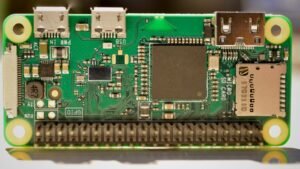With the rapid evolution of technology, more individuals and businesses are looking for quick and cost-effective ways to develop software and digital solutions. Traditional coding can be both time-consuming and expensive, requiring specialized knowledge and expertise. This is where “no code” technology comes in, offering non-technical users the ability to create applications and websites without writing a single line of code. In this article, we will explore the concept of no code tech, its benefits, and how it is revolutionizing the way we build digital solutions.
**Key Takeaways:**
– No code tech enables non-technical users to create software and digital solutions without coding knowledge.
– It is a cost-effective and efficient alternative to traditional coding.
– No code platforms offer a wide range of features and functionalities.
**Understanding No Code Tech: A Game-Changer for Non-Technical Users**
No code tech, also known as “visual programming,” allows individuals with no coding background to create and customize software applications and websites using visual interfaces and drag-and-drop components. By providing a range of pre-built modules and templates, no code platforms empower users to build complex digital solutions without writing a single line of code. This enables even those without technical knowledge to bring their ideas to life and solve problems in innovative ways.
*No code tech provides a bridge between technical and non-technical users, democratizing the creation of digital solutions.*
**The Benefits of No Code Tech**
The rise of no code tech has brought several advantages to non-technical users, businesses, and developers alike. Here are some of the key benefits that make this technology attractive:
1. **Ease and Speed of Development:** With no code tech, anyone can quickly learn and start building functional software solutions without investing extensive time in learning programming languages.
2. **Cost-Effectiveness:** By eliminating the need for specialized developers, no code tech significantly reduces development costs, making it an affordable solution for individuals and small businesses.
3. **Rapid Prototyping:** No code platforms facilitate iterative development, allowing users to test ideas and make changes on the fly, resulting in faster prototyping and efficient product development cycles.
4. **Flexibility and Customizability:** No code tech offers a wide range of pre-built components, modules, and integrations, allowing users to create highly tailored solutions that meet their specific needs.
*No code tech eliminates the need for extensive coding expertise and empowers individuals to focus on their creativity and problem-solving skills.*
**The No Code Landscape: Platforms and Tools**
Numerous no code platforms and tools have emerged in recent years, catering to various user needs. Here are three popular platforms shaping the no code landscape:
1. **Webflow:** A no code platform focused on web development, offering a visual interface to create responsive websites with advanced interactions and animations.
2. **Bubble:** A platform for building web applications with complex functionality, enabling users to create custom database structures and logic while visually designing the front-end.
3. **Adalo:** A no code solution that specializes in mobile app development, providing a visual interface to create native iOS and Android apps, including complex backend functionality.
**Table 1: Comparison of Popular No Code Platforms**
| Features | Webflow | Bubble | Adalo |
|———–|———|——–|——-|
| Responsive Design | ✔️ | ✔️ | ✔️ |
| Custom Database | | ✔️ | ✔️ |
| Complex Interactions | ✔️ | ✔️ | |
| Native Mobile Apps | | | ✔️ |
**Table 2: Cost Comparison of No Code Platforms**
| Platform | Monthly Subscription Cost |
|—————|—————————–|
| Webflow | $12 – $212 |
| Bubble | $29 – $529 |
| Adalo | $35 – $99 |
**Table 3: Users of No Code Tech**
| Type | Examples |
|———–|————–|
| Startups | Zapier, Notion |
| Small Businesses | Local Restaurants, Salons |
| Non-Profit Organizations | Charity Websites, Fundraising Platforms |
*No code platforms cater to different needs, allowing users to choose the one that aligns with their specific project requirements.*
**The Future of No Code Tech**
As technology continues to advance, the no code movement shows no signs of slowing down. With growing adoption and increased functionality, no code tech is expected to become a mainstream method for software development and digital solution creation. As the community of no code users grows, we can anticipate the emergence of more advanced platforms, further enhancing the capabilities and accessibility of this game-changing technology.
*The future of software development lies in empowering non-technical users, as no code tech becomes an essential part of building the digital solutions of tomorrow.*

Common Misconceptions
1. No Code is only for beginners
One common misconception is that no code technology is only suitable for beginners or those who lack programming experience. However, this is far from the truth. No code platforms are designed to empower all individuals, irrespective of their coding prowess. Professionals with coding knowledge can also benefit from no code solutions to streamline their work processes.
- No code can be used by both beginners and experienced programmers.
- No code platforms offer advanced features beyond the basics.
- No code tools can empower experienced developers to build complex applications more efficiently.
2. No Code Tech is limited in functionality
Another misconception is that no code technology is inherently limited in terms of functionality and customization. While it is true that no code platforms may have certain limitations, they have come a long way in providing robust tools and features. No code solutions can be highly flexible, allowing users to create complex applications with sophisticated functionalities.
- No code platforms offer a wide range of templates and integrations.
- No code can handle complex logic and business workflows.
- No code platforms can be used to build scalable and secure applications.
3. No Code is not scalable
Many people wrongly assume that no code solutions are not scalable and can only be used for small projects or prototypes. However, this is not the case. No code platforms have evolved to support scalability, enabling businesses to build and grow their applications as needed. With robust infrastructure and optimization, no code technology can handle larger-scale projects efficiently.
- No code platforms provide scalability options through cloud services and auto-scaling capabilities.
- No code can handle increased user demands and growth without compromising performance.
- No code technology can adapt to the needs of expanding businesses.
4. No Code means giving up control
Some individuals believe that by using no code technology, they will lose control over their projects and become dependent on the platform providers. However, most no code platforms provide users with extensive customization and control options. Users can define their own logic, workflows, and user experience, ensuring they have full control over their applications.
- No code platforms offer customization options through various configuration tools.
- No code allows users to define their own business rules and application behavior.
- No code technology lets users make adjustments and updates to their applications at any time.
5. No Code cannot replace traditional coding
One misconception among developers is that no code technology aims to replace traditional coding altogether. However, the purpose of no code platforms is not to replace coding skills but to empower individuals to build applications more efficiently. While no code technology is beneficial for rapid prototyping and developing certain types of applications, traditional coding still plays a valuable role in more complex projects.
- No code technology complements traditional coding and can be used together in a hybrid approach.
- No code platforms can assist in speeding up the development process for certain applications.
- No code empowers individuals to focus on higher-level problem-solving rather than getting lost in syntax and technical details.

Rise of No Code Platforms
In recent years, the rise of no code technology has transformed the way businesses and individuals develop software applications. No code platforms allow users to create applications without any programming knowledge, empowering non-technical professionals to build functional and engaging software solutions. The following tables highlight the growth, usage, and impact of no code technology across different industries and regions.
Global No Code Adoption
| Region | Percentage of Companies Adopting No Code |
|---|---|
| North America | 45% |
| Europe | 35% |
| Asia | 25% |
| Australia | 20% |
The table above showcases the adoption rates of no code platforms in different regions. North America leads with 45% of companies utilizing no code technology, followed by Europe with 35%.
Industries Benefitting from No Code
| Industry | Key Applications |
|---|---|
| Healthcare | Patient management systems |
| E-commerce | Inventory management |
| Education | Learning management systems |
| Marketing | Lead generation platforms |
This table showcases some key industries that benefit from no code technology. From healthcare to e-commerce, various sectors utilize no code platforms to develop essential applications such as patient management systems and inventory management tools.
Revenue Generation by No Code Platforms
| No Code Platform | Annual Revenue (in millions) |
|---|---|
| Adalo | $10 |
| Bubble | $15 |
| Thunkable | $8 |
| Webflow | $20 |
The above table presents the annual revenue generated by popular no code platforms. These platforms have found financial success by catering to the growing demand for simplified app development tools.
Job Opportunities in No Code
| Job Role | Estimated Monthly Salary (in USD) |
|---|---|
| No Code Developer | $7,000 |
| No Code Consultant | $5,000 |
| No Code Project Manager | $6,500 |
| No Code Evangelist | $4,500 |
The table above illustrates the estimated monthly salaries for various job roles in the no code industry. No code developers and project managers enjoy lucrative salaries, reflecting the demand for their expertise.
No Code Applications in Government
| Government Agency | Implemented No Code Applications |
|---|---|
| Department of Transportation | Permit tracking system |
| Health Department | Contact tracing app |
| Tax Revenue Agency | Tax filing portal |
| Public Works | Maintenance request system |
This table showcases various government agencies that have implemented no code applications to enhance their operations. From permit tracking systems to contact tracing apps, no code technology offers efficient solutions for public administration.
Successful No Code Startups
| Startup | Valuation (in billions) |
|---|---|
| Glide | $1.5 |
| Softr | $2 |
| Retool | $3.5 |
| OutSystems | $9 |
The above table presents successful no code startups and their valuations in billions. These startups have revolutionized the software development landscape by offering intuitive and accessible no code solutions.
User Satisfaction with No Code Platforms
| No Code Platform | User Satisfaction (% of Positive Reviews) |
|---|---|
| Appgyver | 85% |
| Thunkable | 92% |
| Adalo | 79% |
| Webflow | 88% |
The table above represents the user satisfaction levels of popular no code platforms, expressed as the percentage of positive reviews. These platforms have garnered high user ratings, reflecting the ease and effectiveness of their app development capabilities.
Education and Training in No Code
| Platform | Available Courses |
|---|---|
| Udemy | No Code 101: Introduction to App Development |
| Coursera | No Code for Entrepreneurs: Build Apps without Coding |
| LinkedIn Learning | Mastering No Code: Creating Powerful Applications |
| Codecademy | No Code Web Development: From Beginner to Pro |
This table showcases different online learning platforms that offer courses in no code development. These courses cater to aspiring individuals looking to acquire the skills needed to leverage no code platforms effectively.
In conclusion, the emergence of no code technology has democratized software development by empowering non-technical individuals and businesses to create powerful applications. No code platforms have witnessed significant adoption rates, generating substantial revenues and job opportunities. Industries spanning healthcare, e-commerce, education, and government have realized the potential of no code solutions, resulting in the rise of successful startups and high user satisfaction. As the no code movement continues to revolutionize the technology landscape, it provides accessible avenues for individuals to acquire in-demand skills and contribute to innovative software development.
Frequently Asked Questions
Question Title 1
Can I build complex web applications without coding?
Question Title 2
What are some popular no code development platforms?
Question Title 3
Can no code tools be used for mobile app development?
Question Title 4
Are there any limitations to using no code tools?
Question Title 5
Do I need any technical background to use no code platforms?
Question Title 6
Can I integrate APIs and connect to external services using no code tools?
Question Title 7
Can I collaborate with others while using no code platforms?
Question Title 8
Are there any costs associated with using no code platforms?
Question Title 9
Can I deploy the applications I build with no code tools to a custom domain?
Question Title 10
What kind of support is available when using no code platforms?





